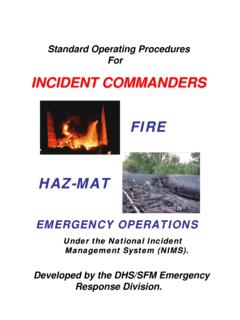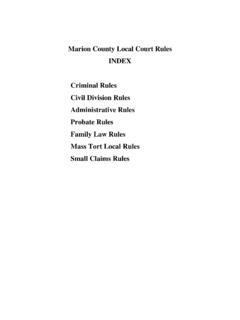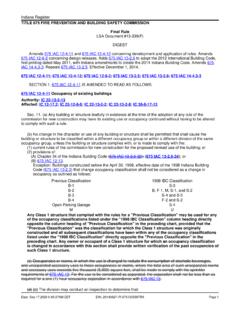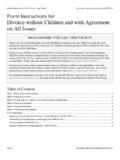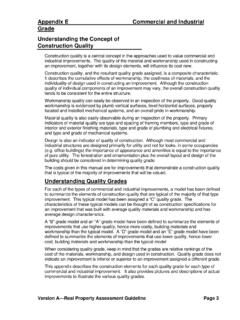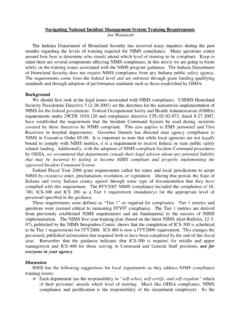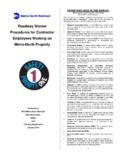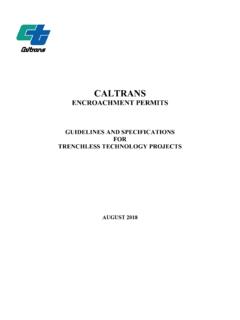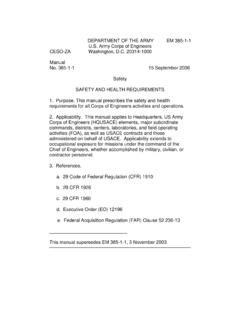Transcription of INDOT 2020 Standard Specifications - IN.gov
1 INDIANA DEPARTMENT OF TRANSPORTATION _____ Standard Specifications 2020 ERIC HOLCOMB GOVERNOR INDIANA DEPARTMENT OF TRANSPORTATION Joe McGuinness COMMISSIONER STANDARDS COMMITTEE CHAIRMAN John Leckie, Construction and Materials Management Director MEMBERS Matt Beeson, Materials Management Michael Beuchel, Contract Administration David Boruff, Traffic Engineering Kumar Dave, Pavement Engineering Louis Feagans, Statewide Technical Services Michael Koch, Fort Wayne District Construction Mark Orton, Bridge Standards and Policy Greg Pankow, State Construction Engineer Kurt Pelz, Construction Technical Support Elena Veksler, Highway Design and Technical Support SECRETARY Scott Trammell, Construction Specifications Engineer Lana Podorvanova, Specifications Coordinator iii MEASUREMENTS The first two paragraphs of , Measurement of Quantities reads as follows: (a) General Requirements All measurements of work completed under the contract will be according to the English System unless otherwise specified.
2 The Standard measures shown in this publication are primarily in the English System of Units such as feet and inches, pounds, gallons, and acres. Any metric equivalents, shown in parentheses, are intended only for those contracts in which they are specified, or to maintain consistency with industry standards. No guarantee is provided, explicit or implicit, that the units are accurate conversions. The following table and general notes are provided to assist you in becoming familiar with the metric system.
3 Iv SI UNITS AND CONVERSION FACTORS MEASUREMENT ENGLISH UNIT ENGLISH UNIT SYMBOL MULTIPLIER FOR CONVERSION FROM ENGLISH UNIT TO SI UNIT (*) SI UNIT SI SYMBOL Acceleration foot per second squared mile per hour squared ft/sec2 mi/h2 8 exactly 93 meter per second squared kilometer per hour squared m/s2 km/h2 Area square inch square foot square yard acre square mile in2 ft2 yd2 ac mi2 exactly 9 1 7 square millimeter square meter square meter hectare square kilometer mm2 m2 m2 ha km2 Density pound per
4 Cubic foot lb/ft3 46 kilogram per cubic meter kg/m3 Energy foot pound force kilowatt hour ft lbf kW h 8 3 600 000. exactly joule joule J J Force/Weight (Gravity of Force) pound force kilopound force ton lbf kip t 2 2 4 newton kilonewton kilonewton N kN kN Length inch foot yard mile in. ft yd mi exactly 8 exactly 4 exactly 3 millimeter meter meter kilometer mm m m km Mass ounce pound mass ton mass oz lbm t 5 6 2 gram kilogram megagram g kg Mg Power horsepower (550 ft lbf/s)
5 Hp 9 watt W Pressure/Stress pound per square inch pound per square foot kilopound per square inch lb/in2 lb/ft2 kip/in2 8 88 8 kilopascal kilopascal megapascal kPa kPa MPa Speed/Velocity foot per second mile per hour ft/s mi/h 8 exactly 3 meter per second kilometer per hour m/s km/h v Temperature degree Fahrenheit F ( F -32) (**) exactly degree Celsius C Volume, Fluid cubic inch fluid ounce gallon 1000 gallons in3 fl oz gal. kGAL. 1 4 4 4 milliliter milliliter liter kiloliter mL mL L kL Volume, Solid cubic inch cubic foot bushel cubic yard 1000 feet board measure in3 ft3 bu yd3 MFBM exactly 32 24 6 7 cubic millimeter cubic meter cubic meter cubic meter cubic meter mm3 m3 m3 m3 m3 (*) Conversion from SI unit to English unit may be made by dividing the SI unit by the conversion factor shown in this column.
6 (**) This is a formula, and not a multiplier. The Fahrenheit temperature is substituted for F in the formula to attain the Celsius temperature. Conversion from Celsius temperature to Fahrenheit temperature may be made by substituting the Celsius temperature for C in the formula ( x C) +32. This is an exact conversion. Angles will continue to be measured in degrees, minutes, and seconds instead of radians. vi GENERAL NOTES 1. The SI unit of millimeter should be used to convert inches to millimeters. 2. The SI unit of Mass is the Kilogram (Kg) which should be used for smaller masses expressed in pounds.
7 The megagram (Mg) should be used for larger masses expressed in tons. 3. All units peculiar to the various cgs systems (measurement systems constructed by using the centimeter, gram and second as base units) are to be avoided. 4. In commercial and everyday use, the term weight nearly always means mass; thus, when one speaks of a person s weight, the quantity referred to is mass. In Science and Technology, the term weight of a body has usually meant the force that, if applied to the body, would give it an acceleration equal to the local acceleration of free fall g (acceleration of gravity).
8 When the term is used, it is important to know whether mass or force is intended and to use SI Units properly, by using Kilograms for Mass or Newtons for Force. The use of force of gravity (mass times acceleration of gravity) instead of weight with this meaning is recommended. Because of the dual use of the term weight as a quantity, this term should be avoided in technical practice except under circumstances in which its meaning is completely clear. 5. The term load means either mass or force, depending on its use.
9 A load that produces a vertically downward force because of the influence of gravity acting on a mass may be expressed in mass units. Any other load is expressed in force units. 6. A quantity stated as limits, such as not more than or maximum , must be handled so that the stated limit is not violated. 7. Conversion of quantities should be handled with careful regard to the implied correspondence between the accuracy of the data and the given number of digits. In all conversions, the number of significant digits retained should be such that accuracy is neither sacrificed nor exaggerated.
10 For example, a length of 125 ft converts exactly to m. If however, the 125 ft length has been obtained by rounding to the nearest 5 ft, the conversion should be given as 38 m. The proper conversion procedure is to multiply a value by a conversion factor that is more accurate than is required, the result is then rounded to the appropriate number of significant digits. 8. For calculation of results, avoid rounding of intermediate quantities. For reporting results, the rule for addition and subtraction is that the answer shall contain no significant digits farther to the right than occur in the least precise number.
